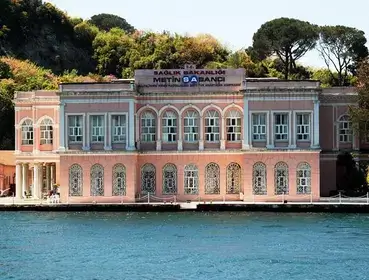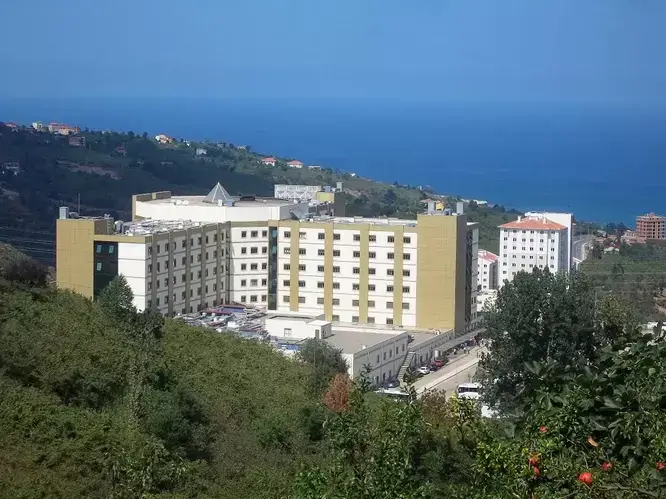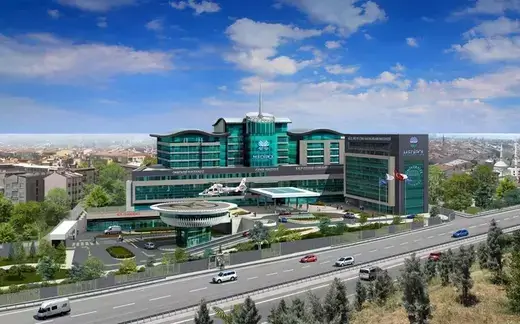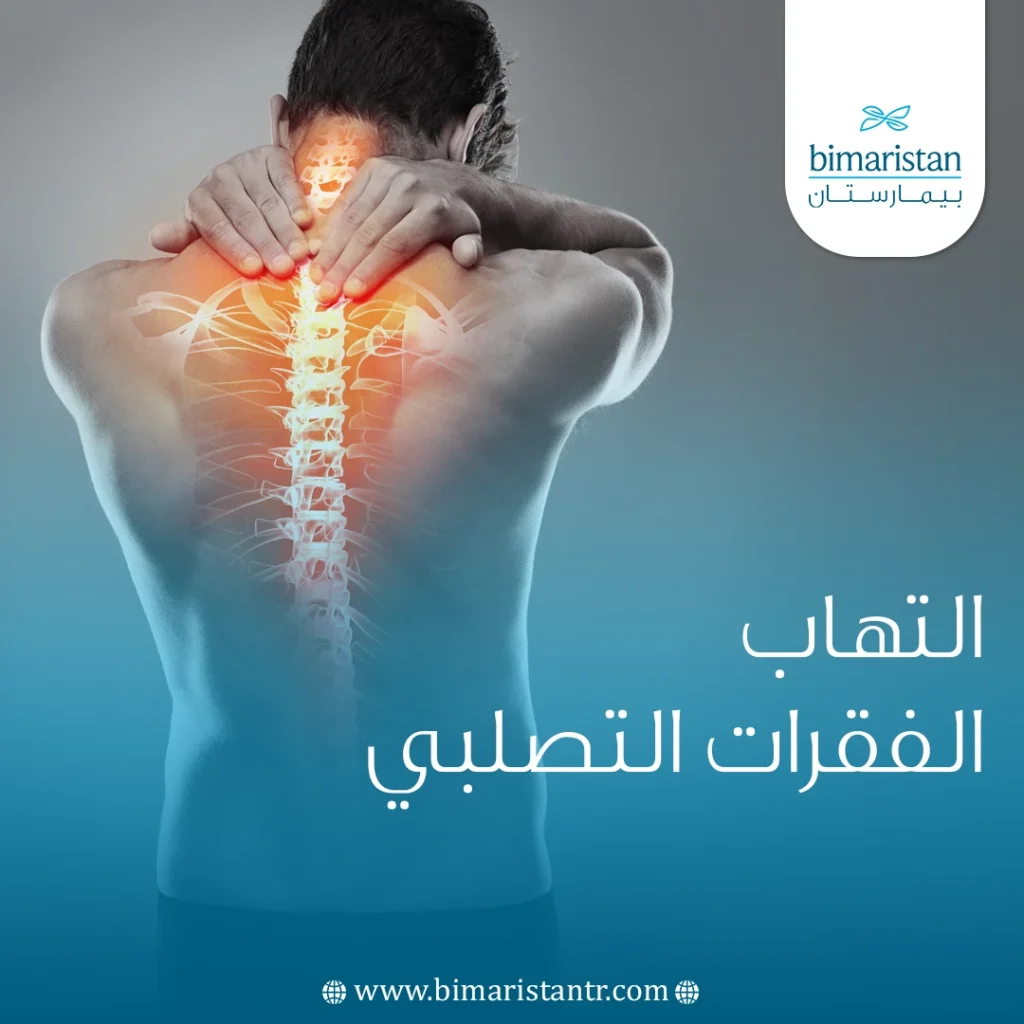التهاب الفقرات التصلبي هو مرض التهابي يصيب العمود الفقري مؤدياً لتصلبه وصعوبة تحريكه بسبب تيبس المفاصل، يدعى طبياً بالتهاب الفقار اللاصق Ankylosing Spondylitis.
يسبب مرض التهاب الفقرات التصلبي ألماً شديداً يعيق المريض عن أداء مهامه اليومية ويجعله عضواً غير فاعل في المجتمع، خاصة وأنه يصيب الشباب في مقتبل العمر حوالي العقدين الثالث والرابع مما يؤدي لخسائر اقتصادية وصحية كبيرة في المجتمع.
لذلك يجب على المريض اللجوء للرعاية الصحية مباشرة لتدبير مرض التهاب الفقار اللاصق والسيطرة عليه كي يعود قادراً على متابعة حياته بشكل طبيعي. المرض غير قابل للشفاء بشكل كامل لكن الامتثال للعلاج الصحيح يحسن من حياة المصاب بشكل جذري. تابع معنا في هذه المقالة لتتعرف على مرض التهاب الفقرات التصلبي بالتفصيل وكيفية علاجه في تركيا.
ما هو التهاب الفقرات التصلبي؟
يعتبر مرض التهاب الفقرات التصلبي مرض مناعي ذاتي وهو من الأمراض الالتهابية المزمنة التي تصيب الشباب حوالي العقد الثالث أو الرابع من العمر وتؤدي لحدوث آلام في مختلف أنحاء الجسم. يتركز الألم بشكل أساسي في الظهر ويظهر ليلاً ويستمر لفترة طويلة مسبباً صعوبة الحركة.
الظهر ليس المكان الوحيد لظهور الألم في مرض التهاب الفقار المقسط، فإصابة المفصل الحرقفي العجزي شائعة أيضاً مسببة بذلك ألماً في منطقة الألية (الأرداف) أسفل ظهر المريض يبدأ على شكل ألم أحادي الجانب ثم يصبح في كلا الجانبين. تصاب أيضاُ مفاصل الكتف، الكاحل، الورك والركبة في التهاب الفقار القسطي.
تعتمد آلية مرض التهاب الفقرات التصلبي على حدوث تفاعل التهابي مزمن في المفاصل ومرتكزات الأربطة والأوتار على العظام بسبب تشكل مناعة من الجسم ضد هذه الأنسجة (يهاجم الجسم نفسه – مناعة ذاتية) مما يؤدي لتآكل المفاصل وانقطاع الأوتار أو تخربها بشكل كبير وتشكل المناقير العظمية ومن ثم التحام الفقرات مع بعضها. يؤدي ذلك لتصلب العمود الفقري وصعوبة تحريك الرقبة والظهر (تيبس الرقبة وزيادة انحناء الظهر للأمام).
أعراض التهاب الفقار اللاصق العظمية
تقسم أعراض التهاب الفقرات التصلبي إلى أعراض عظمية تصيب العمود الفقري وسائر مفاصل الجسم وأعراض خارج عظمية قد تصيب العينين أو الأمعاء أو أعضاء أخرى لدى مريض التهاب الفقار التصلبي، وتختلف الأعراض بشكل كبير من مريض لآخر.
وتشتمل الأعراض العظمية على الألم، اليبوسة وصعوبة تحريك المفصل المتضرر من الالتهاب، تصاب المفاصل بين الفقرات والأربطة المتصلة بها، بالإضافة للعظام المتمفصلة مع فقرات الظهر.
من أهم هذه المفاصل المفصل الحرقفي العجزي (مفصل بين العمود الفقري وعظم الحوض) والمفاصل الفقرية الضلعية. تؤدي إصابة المفاصل في مرض التهاب الفقار اللاصق إلى حدوث تصلب وألم في أسفل الظهر والعنق والأرداف والكتفين واليدين والصدر (القفص الصدري) والخاصرتين والقدمين والكعبين والفخذ من الخلف.
يظهر هذا الألم عادة في منتصف الليل ويستمر لعدة ساعات ولا يزول بالراحة وقد يستيقظ المريض بسببه. قد يكون هذا الألم أسوأ صباحاً بالإضافة لصلابة وصعوبة تحريك المفصل المصاب وتورمه. وتستمر عادة هذه الأعراض لمدة ثلاثة أشهر على الأقل. تظهر أيضا أعراض مثل:
- ظهور الألم بعد الراحة المطولة
- حرارة خفيفة
- فقدان الشهية ونقص الوزن
- هشاشة العظام وسهولة حدوث كسور فيها
- صعوبة التنفس العميق بسبب تحدد حركة القفص الصدري
- التعب المستمر والإرهاق
- انحناء الظهر والعمود الفقري للأمام
- التهاب القرص الليفي بين الفقرات في العمود الفقري
- آلام في مفاصل أخرى بسبب حدوث التهاب المرتكزات Enthesitis (مكان ارتباط الأوتار والأربطة بالعظام)
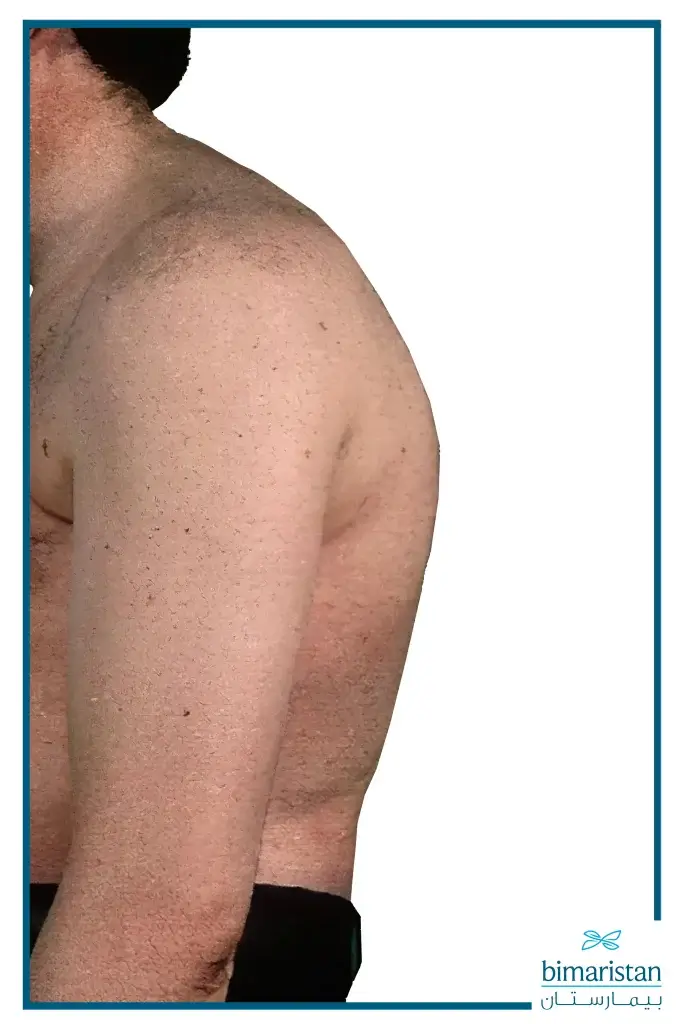
مضاعفات التهاب الفقار اللاصق خارج العظمية
قد يصيب مرض التهاب الفقرات التصلبي أعضاء خارج العمود الفقري والجهاز الحركي مما يضلل تشخيص المرض، يسمي البعض الإصابات خارج العظام لهذا المرض بمضاعفات التهاب الفقرات التصلبي، وهي كالتالي:
الإصابة العينية
تسبب الإصابة العينية لمرض التهاب الفقرات القسطي بما يلي:
- ألم واحمرار العين
- تشوش الرؤية
- خوف الضوء
وذلك بسبب تسببه بالتهاب العنبة الأمامية في العين Uveitis.
التظاهرات الهضمية
يصاب الجهاز الهضمي أيضًا في هذا المرض بحالة تسمى الداء المعوي الالتهابي IBD (وتشمل داء كرون والتهاب الكولون التقرحي) مما يسبب اسهال مخاطي مدمى ونوبات من الألم البطني.
الأعراض العصبية
قد يؤثر التهاب المفاصل في العمود الفقري على الأعصاب المجاورة بسبب حدوث كسر في الفقرات أو خلع فيها، تظهر نتيجة لذلك أعراض عصبية تتمثل بـ:
- التنميل والخدر
- الألم
- فقدان الحس أو الحركة
وذلك حسب العصب المصاب والأعضاء المسؤول عن تعصيبها.
أعراض أخرى
قد يسبب التهاب الفقرات التصلبي اضطرابات نظم قلبية أو التهاب في منشأ الشريان الأبهر بسبب تطور المرض لديهم في حالات نادرة.
كما قد يتسبب الالتهاب المزمن لدى المريض بحدوث تليف رئوي أو كلوي لكن هذه الحالة نادرة الحدوث عند الإصابة بالتهاب الفقرات التصلبي.
التهاب الفقار اللاصق والحمل
لا يوجد دليل على تأثير التهاب الفقار اللاصق على الحمل أو القدرة على الإنجاب لكن يبقى التخطيط لموعد الحمل أمراً مهماً من أجل تغيير بعض الأدوية التي تأخذها المريضة بما يتناسب مع الحمل. قد تخف أعراض التهاب الفقرات الروماتيزمي لدى بعض النساء أثناء الحمل.
ما هي أسباب حدوث التهاب الفقرات التصلبي؟
يصيب التهاب الفقرات التصلبي الشباب الذكور غالباً بأعمار تتراوح بين 20-40 سنة. لم يُعرف إلى الآن المسبب المباشر لحدوث مرض التهاب الفقرات التصلبي الذي يصيب العمود الفقري أو المفاصل المحيطة به ولكن الدراسات وجدت ارتباطاً قوياً بين البشر الحاملين للزمرة HLA-B27 على الكريات البيض وارتفاع نسبة الإصابة بالتهاب الفقار اللاصق.
ليس كل الحاملين لهذه الزمرة سوف يصابون بمرض التهاب الفقار (إنما نسبة كبيرة منهم تقدر بـ 80%)، وليس جميع المصابين بالالتهاب الفقاري لديهم هذه الزمرة.
لكن وكما أسلفنا يوجد ارتباط بين الإصابة بالمرض ووجود الزمرة لدى المصاب بشكل كبير حسب الدراسات الحديثة، يوجد احتمال بنسبة 50% لتوريث هذه الزمرة، أي أن التهاب الفقار اللاصق قد يكون مرضاً وراثياً في بعض الحالات.
تشخيص التهاب الفقرات التصلبي
يعتمد تشخيص التهاب الفقرات التصلبي بدايةً على القصة السريرية والأعراض التي يشتكي منها المريض ثم بالفحص السريري، بعد رؤية هذه التظاهرات يشتبه الطبيب بإصابة مريضه بالتهاب الفقار اللاصق (تصلب العمود الفقري)، خاصةً إذا كان المريض شاباً في مقتبل العمر لشيوع التهاب المفاصل الروماتويدي لدى هذه الفئة من الناس.
يطلب نتيجة لذلك عدة استقصاءات شعاعية ومخبرية وهي:
- اختبار سرعة التثفل ESR: تزداد سرعة التثفل في كثير من الأمراض ومنها التهاب الفقرات التصلبي.
- صورة شعاعية X-Ray للعمود الفقري أو المفاصل المصابة.
- تحليل زمرة HLA-B27.
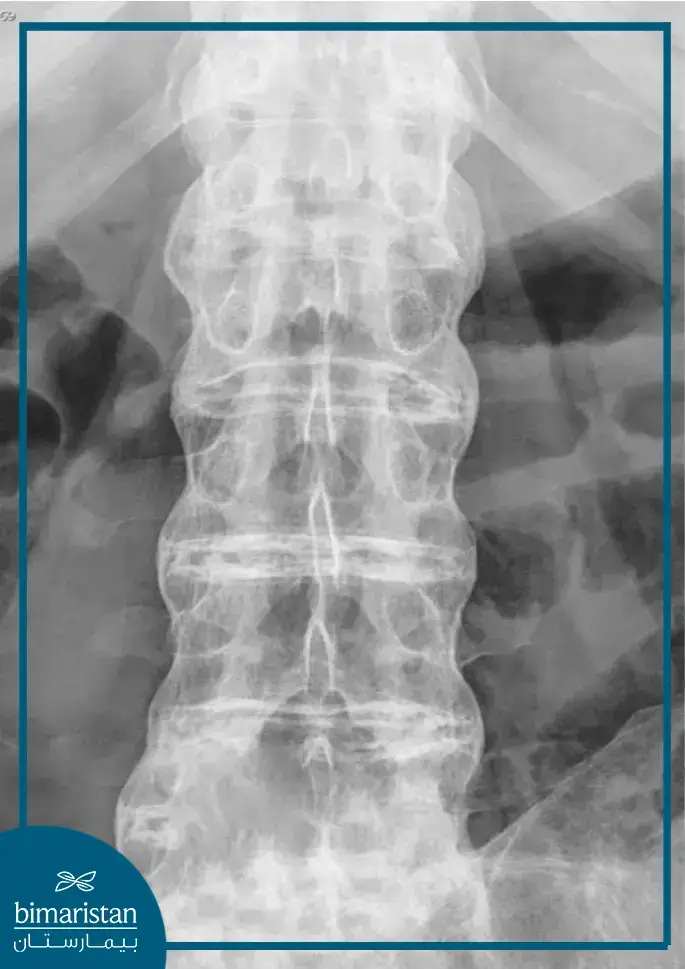
وقد يحتاج الطبيب اختبارات أخرى أكثر نوعية في حال اشتباه الحالة بحالات مرضية أخرى من أجل التفريق بينها ووضع التشخيص الصحيح لدى المريض، كما أن تشخيص التهاب الفقرات الروماتويدي يعتمد على معايير معينة، وجود أحدها قد يرجح كفة الإصابة بالمرض كثيراً، وهي:
- ألم التهابي أسفل الظهر يستمر لأكثر من 3 أشهر.
- تحدد حركة العمود الفقري السفلي وعدم مقدرة المريض على الانحناء للأمام أو الجانبين.
- تحدد حركة الصدر وعدم مقدرة المريض على التنفس بشكل عميق.
علاج التهاب الفقار اللاصق في تركيا
يُعالج التهاب الفقرات التصلبي من قبل الطبيب المختص بالأمراض الرثوية (أمراض المناعة الذاتية والروماتيزم والمفاصل) Rheumatologist، والذي يُقيّم حالة المريض بشكل دقيق ويصف العلاج النوعي له بناءاً على حالته.
تستهدف طرق العلاج السيطرة على أعراض المرض وعلاج الألم والتيبس الناجمين عنه. وتتضمن العلاج الدوائي، العلاج الفيزيائي والعلاج الجراحي في بعض الحالات وجميعها يحسن حالة المريض بشكل كبير ويبطء (وقد يوقف) تطور المرض. لا يوجد علاج شافي بشكل نهائي لمرض التهاب الفقار اللاصق.
العلاج الدوائي لمرض التهاب الفقرات التصلبي
تتنوع الزمر الدوائية التي يصفها طبيب الأمراض الرثوية لعلاج مرض روماتيزمي يصيب العمود الفقري كالتهاب الفقرات التصلبي لعدة خطوط علاجية، في حال عدم نجاح خط علاجي ننتقل للتالي والذي يكون أقوى منه حتى يتم احتواء المرض والسيطرة عليه.
كلما زادت قوة الدواء المستخدم للعلاج زادت التأثيرات الجانبية الناجمة عن استخدامه، لذلك لا نباشر بالأدوية الشديدة في بداية المعالجة ونستخدم الدواء الأكثر نفعاً للمريض والأقل كلفة وتأثيرات جانبية. ومنها:
مسكنات الألم ومضادات الالتهاب غير الستيروئيدية NSAIDs
كالباراسيتامول والإيبوبروفين هي الأدوية الأولية لتدبير وعلاج التهاب الفقرات التصلبي، في حال عدم نجاحها في تسكين آلام المريض نستخدم أدوية ذات تأثير أقوى.
الأدوية المضادة للروماتيزم والمعدلة لسير المرض DMARDs
تعمل هذه الأدوية على تقليل العملية الالتهابية في الجسم وتحسين أعراض المريض خاصة في اليدين والقدمين، بالإضافة لحماية المفاصل من التخرب، لكنها تعتبر ضعيفة الفعالية بالنسبة للأعراض المتعلقة بالعمود الفقري.
من أهم هذه الأدوية الميثوتريكسات والسلفاسالازين. عند استخدام هذه الأدوية لعلاج مرض الفقار اللاصق تجب متابعة المريض بشكل مستمر لتجنب أي أعراض جانبية قد تحدث نتيجة العلاج بها. وتعتبر ممتازة للسيطرة على الألم والتيبس في مفاصل المريض.

العلاج البيولوجي لالتهاب الفقار اللاصق
هذه الفئة هي أحدث أدوية علاج التهاب الفقرات التصلبي ولكن استخدامها يجب أن يكون بحذر وتحت إشراف الطبيب المختص، تعمل هذه الأدوية على تقليل العملية وإيقاف عملية المناعة الذاتية المسببة للمرض عبر استهداف أحد المكونات الهامة لهذه العملية (مثل العامل المنخر للورم TNF أو الانترلوكين 17)، ومن أهم هذه الأدوية (دواء جديد لعلاج التهاب الفقار اللاصق الروماتيزمي):
- إيتانيرسيبت
- غوليموماب
- أداليموماب
- سيتروليزوماب بيغول
- سيكيوكينوماب
علاج التهاب الفقار المقسط بالستيروئيدات
الأدوية الستيروئيدية (مثل الكورتيزون) هي الأدوية المستخدمة لعلاج هجمات التهاب الفقرات التصلبي، تستخدم إما حقناً ضمن المفصل الملتهب أو عضلياً، كما توجد منها أقراص فموية وقطرات عينية.
نلجأ لقطرات الستيروئيد في حالة الالتهابات العينية المرافقة لالتهاب الفقار الروماتيزمي. لا تستخدم هذه الفئة الدوائية لفترة طويلة في العلاج نظراً لتأثيراتها الجانبية وكأي دواء آخر؛ توجه لطبيبك فوراً في حال لاحظت أي تأثرات جانبية نتيجة معالجة التهاب الفقرات التصلبي.
العلاج الطبيعي لالتهاب الفقار اللاصق في تركيا
يعد العلاج الفيزيائي أساسياً في تدبير التهاب الفقار اللاصق وذلك من أجل الحفاظ على القوة العضلية ومنع تيبس العمود الفقري أو المفاصل وفقد قدرتها على الحركة.
يمكنك التعرف أكثر عن العلاج الفيزيائي في تركيا.
سوف ينصحك المعالج الفيزيائي لدينا بمجموعة تمارين يومية (تمارين التهاب الفقار اللاصق) بالإضافة للحفاظ على وضعية معينة مناسبة لحالتك. من الطرق الحديثة لدينا أيضاً العلاج المائي لالتهاب الفقار اللاصق، يتضمن مجموعة تمارين تجرى ضمن بركة ماء دافئ لتحسين أعراض المرض.
علاج التهاب الفقار اللاصق بالجراحة في تركيا
لا يحتاج معظم مرضى التهاب الفقرات التصلبي إلى الجراحة، لأن أغلب الأعراض يمكن السيطرة عليها دوائياً. تعتبر الجراحة مفيدة جداً لمرضى التهاب الفقار القسطي في حال تخرب أحد المفاصل مما يستدعي استبداله، وأهمها استبدال مفصل الورك واستبدال مفصل الركبة في حال إصابتها بشدة وتخربها.
عادةً لا نلجأ للعمل الجراحي على العمود الفقري إلا في حالات خاصة والتي يعتبر التدخل فيها مفيداً جداً لحياة المريض ومحسناً لحالته، يتطلب إجراء عمل جراحي على العمود الفقري خبرة كبيرة، يتوفر في مركزنا أمهر أطباء الجراحة العظمية في تركيا من أجل إجراء مثل هذه العمليات النوعية.
التهاب الفقرات التصلبي مرض مناعي ذاتي يصيب مفاصل المريض وقد يخربها، تعتبر مفاصل العمود الفقري الأكثر إصابة مؤدياً لتخرب الفقرات واندماجها ببعضها، ومن هنا اكتسب اسمه. تصاب مفاصل عديدة أخرى خارج العمود الفقري، كما أن الإصابة لا تقتصر على المفاصل والعظام فقط؛ فقد تحدث إصابات عينية أو هضمية أيضاً. يعالج التهاب الفقار اللاصق باستخدام الأدوية والعلاج الفيزيائي وقد نلجأ للجراحة لإصلاح المفاصل التالفة.
المصادر:




